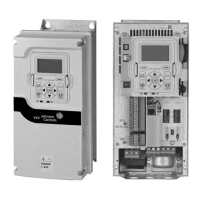180
Appendix A—Description of parameters
VARIABLE SPEED DRIVE SERIES III LIT-12012999—June 2018 www.johnsoncontrols.com
Code Modbus ID Parameter Application RO/RW
P6.4.5 325 OverVoltage Attempts 1,2,3 RW
This parameter determines the number of allowed restart-attempts after “DC-Overvoltage” condition
has occured.
0 = No automatic restart after overvoltage fault trip
>0 = Number of automatic restarts after overvoltage fault trip. The fault is reset and the drive is started
automatically after the DC-link voltage has returned to the normal level.
P6.4.6 326 OverCurrent Attempts 1,2,3 RW
This parameter determins the number of allowed restart-attempts after “Overcurrrent” condition has
occured.
Note: An IGBT temperature fault, Saturation Fault and Overcurrent Faults are included as part of this
fault.
0 = No automatic restart after overcurrent fault trip
>0 = Number of automatic restarts after an overcurrent trip, saturation trip or IGBT temperature fault.
P6.4.7 327 4mA Fault Attempts 1,2,3 RW
This parameter determins the number of allowed restart-attempts after “4-20mA fault” condition has
occured.
0 = No automatic restart after reference fault trip
>0 = Number of automatic restarts after the analog current signal (4–20 mA) has returned to the normal
level (>4 mA)
P6.4.8 329 Motor Temp Fault Attempts 1,2,3 RW
This parameter determines the number of allowed restart-attempts after “Thermistorfault Motor”
condition has occured.
0 = No automatic restart after Motor temperature fault trip
>0 = Number of automatic restarts after the motor temperature has returned to its normal level
P6.4.9 328 External Fault Attempts 1,2,3 RW
This parameter determines the number of allowed restart-attempts after “External Fault” condition has
occured.
0 = No automatic restart after External fault trip
>0 = Number of automatic restarts after External fault trip
P6.4.10 336 Underload Attempts 1,2,3 RW
This parameter determines the number of allowed restart-attempts after “Underload Motor” condition
has occured.
0 = No automatic restart after an Underload fault trip
>0 = Number of automatic restarts after an Underload fault trip
P7.1.1 1294 PID1 Control Gain 2,3 RW
This parameter is used to defines the proportional gain of the PID Controller. It adjust the slope of the
speed increase according to the initial of the load. If this value is set to 100% a change of 10% in the
error value causes the controller output to change 10%.
P7.1.2 1295 PID1 Control ITime 2,3 RW
This parameter is used to defines the integration time constant of the PID Controller. Over the time the
integral time contributes to the deviation between the reference and the feedback signal. If this value is
set to 1.00 sec, a change of 10% in the error value causes the controller output to change by 10.00%/s.
With value set to 0.0, frequency converter operates as PD controller.
P7.1.3 1296 PID1 Control DTime 2,3 RW
This parameter is used to defines the derivation time constant of the PID Controller. This value will
adjust the rate of change on the feedback signal. If this value is set to 1.00 sec, a change of %10 in error
value during 1.00 sec causes the control output to change by %10.00. If value is set to 0.0, frequency
converter operates as PI controller.
P7.1.4 1297 PID1 Process Unit 2,3 RW
This parameter is used to defines the unit type for PID controller. This will change the Feedback and
Setpoint variables to show the desired unit of measure.
P7.1.5 1298 PID1 Process Unit Min 2,3 RW
This parameter is used to defines the minimum process unit value for the PID controller.
P7.1.6 1300 PID1 Process Unit Max 2,3 RW
This parameter is used to defines the maximum process unit value for the PID controller.

